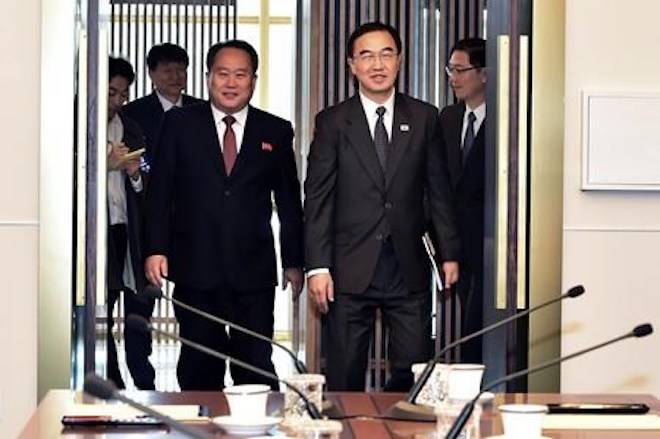North and South Korea continued their push for peace Monday with high-level talks that resulted in a host of agreements, including a plan by the rivals for a groundbreaking ceremony this year on an ambitious project to connect their railways and roads.
The agreements come amid unease in Washington over the speed of inter-Korean engagement. Many outsiders believe that U.S.-led efforts to rid the North of its nuclear-tipped missiles are lagging significantly behind the Koreas’ efforts to move past decades of bitter rivalry.
A series of weapons tests by North Korea last year, and an exchange of insults and threats between President Donald Trump and North Korean leader Kim Jong Un, had many on the Korean Peninsula fearing war. But there has since been a surprising peace initiative, with three inter-Korean summits and a June meeting in Singapore between Trump and Kim. The U.S. and North Korea are working on plans for a second such summit.
Still, there is widespread skepticism that North Korea will disarm. And, despite the fanfare for the proposed railway and road projects, the Koreas cannot move much further along without the lifting of international sanctions against North Korea, which isn’t likely to come before it takes firmer steps toward relinquishing its nuclear weapons and missiles.
South Korea’s Unification Ministry, which handles affairs with the North, said in a statement that the government will share details from Monday’s meeting with the United States and other nations and will closely co-ordinate with them to avoid any friction over sanctions.
The ministry said the rivals agreed Monday to hold general-level military talks soon to discuss reducing border tensions and setting up a joint military committee that’s meant to maintain communication and avoid crises and accidental clashes.
The Koreas also agreed to use their newly opened liaison office in the North Korean border town of Kaesong to host talks between sports officials in late October to discuss plans to send combined teams to the 2020 Summer Olympics and to make a push to co-host the 2032 Summer Games.
And the two countries will hold Red Cross talks at North Korea’s Diamond Mountain resort in November to set up video-conference meetings between aging relatives separated by the 1950-53 Korean War and potentially expand face-to-face reunions between them.
Monday’s talks at the border village of Panmunjom were aimed at finding ways to carry out peace agreements announced after a summit last month between South Korean President Moon Jae-in and Kim in the North Korean capital of Pyongyang.
Related: North and South Korea say they plan to bid for 2032 Olympics
Related: Korean leaders meet in Pyongyang for potentially tough talks
South Korean Unification Minister Cho Myoung-gyon said it was meaningful that the Koreas are getting faster in reaching agreements as their diplomacy gains traction. His North Korean counterpart, Ri Son Gwon, who heads an agency dealing with inter-Korean affairs, said “no group and no force will be able to prevent the path toward peace, prosperity and our nation’s unification.”
At the most recent summit between Moon and Kim, the two leaders committed to reviving economic co-operation when possible, voicing optimism that international sanctions could end and allow such activity.
They also announced measures to reduce conventional military threats, such as creating buffer zones along their land and sea boundaries and a no-fly zone above the border, removing 11 front-line guard posts by December, and demining sections of the Demilitarized Zone.
Moon has described inter-Korean engagement as crucial to resolving the nuclear standoff and is eager to restart joint economic projects held back by sanctions if the larger nuclear negotiations between the United States and North Korea begin yielding results.
However, South Korea’s enthusiasm for engagement with its rival appears to have created discomfort with the United States, a key ally.
Moon’s government last week walked back a proposal to lift some of its unilateral sanctions against North Korea following Trump’s blunt retort that Seoul could “do nothing” without Washington’s approval.
South Korean Foreign Minister Kang Kyung-wha also said U.S. Secretary of State Mike Pompeo expressed displeasure about the Koreas’ military agreements. Kang was not specific, but her comments fueled speculation that Washington wasn’t fully on board before Seoul signed the agreements.
Trump has encouraged U.S. allies to maintain sanctions on North Korea until it denuclearizes to maintain a campaign of pressure against Kim’s government.
Experts say updating North Korean trains, which use rails that were first laid in the early 20th century, could take decades and cost tens of billions of dollars.
In Monday’s meeting, the Koreas also agreed to conduct joint inspections during late October of the North Korean portion of a railway that once connected Seoul and Sinuiju, before moving on to railways in the eastern section in early November. A groundbreaking ceremony for the project is planned for November or early December.
Originally built by Japan, the Gyeongui line between Seoul and Sinuiju was separated at the end of World War II in 1945, when the Korean Peninsula was liberated from Japanese colonial rule and divided between a U.S.-controlled southern side and a Soviet-controlled north.
The line was briefly reconnected during a previous era of rapprochement between the rivals in the 2000s. The Koreas in December 2007 began freight services between South Korea’s Munsan Station in Paju and North Korea’s Pongdong Station, which is near Kaesong where the Koreas once operated a joint factory park. But the line was cut again in 2008 when a new conservative government took over in Seoul.
Kim Tong-Hyung, The Associated Press



